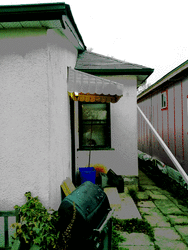The bedrooms and kitchen are about 10x10 each and the living room is 10x20.
See the layout in the previous post. The porch is about 7x20. Ceiling are 10', but in the living room there is a suspended ceiling, made out of a 2x4 frame and paper (cardboard like) tiles. I placed an old Huron oven stove where the new one will be to see how it will look. The old stove has some rust holes, not to mention must be inefficient and probably needs tons of clearance. I bought it without knowing anything about stoves.
I assume you have insulation in the attic, and lots of it. If not, I would respectfully suggest that should be first on your list, before windows or a stove. And definately an easy do it yourself job!



 . Seriously, the BK sounds like that it an awesome stove.
. Seriously, the BK sounds like that it an awesome stove.